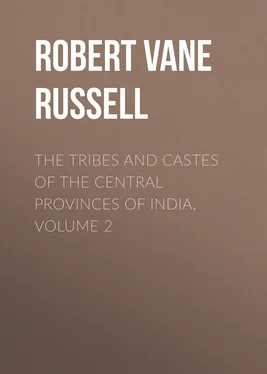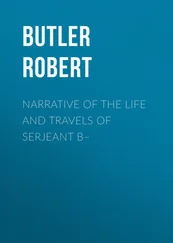Robert Vane Russell - The Tribes and Castes of the Central Provinces of India, Volume 2
Здесь есть возможность читать онлайн «Robert Vane Russell - The Tribes and Castes of the Central Provinces of India, Volume 2» — ознакомительный отрывок электронной книги совершенно бесплатно, а после прочтения отрывка купить полную версию. В некоторых случаях можно слушать аудио, скачать через торрент в формате fb2 и присутствует краткое содержание. Жанр: foreign_prose, История, foreign_edu, foreign_antique, на английском языке. Описание произведения, (предисловие) а так же отзывы посетителей доступны на портале библиотеки ЛибКат.
- Название:The Tribes and Castes of the Central Provinces of India, Volume 2
- Автор:
- Жанр:
- Год:неизвестен
- ISBN:нет данных
- Рейтинг книги:4 / 5. Голосов: 1
-
Избранное:Добавить в избранное
- Отзывы:
-
Ваша оценка:
- 80
- 1
- 2
- 3
- 4
- 5
The Tribes and Castes of the Central Provinces of India, Volume 2: краткое содержание, описание и аннотация
Предлагаем к чтению аннотацию, описание, краткое содержание или предисловие (зависит от того, что написал сам автор книги «The Tribes and Castes of the Central Provinces of India, Volume 2»). Если вы не нашли необходимую информацию о книге — напишите в комментариях, мы постараемся отыскать её.
The Tribes and Castes of the Central Provinces of India, Volume 2 — читать онлайн ознакомительный отрывок
Ниже представлен текст книги, разбитый по страницам. Система сохранения места последней прочитанной страницы, позволяет с удобством читать онлайн бесплатно книгу «The Tribes and Castes of the Central Provinces of India, Volume 2», без необходимости каждый раз заново искать на чём Вы остановились. Поставьте закладку, и сможете в любой момент перейти на страницу, на которой закончили чтение.
Интервал:
Закладка:
10. Language.
As already stated, the Baigas have completely forgotten their own language, and in the Satpūra hills they speak a broken form of Hindi, though they have a certain number of words and expressions peculiar to the caste.
Bairāgi
1. Definition of name and statistics.
Bairāgi, 98 98 This article contains material from Sir E. Maclagan’s Punjab Census Report (1891), and Dr. J. N. Bhattachārya’s Hindu Castes and Sects (Thacker, Spink & Co., Calcutta).
Sādhu.—The general term for members of the Vishnuite religious orders, who formerly as a rule lived by mendicancy. The Bairāgis have now, however, become a caste. In 1911 they numbered 38,000 persons in the Provinces, being distributed over all Districts and States. The name Bairāgi is supposed to come from the Sanskrit Vairāgya and to signify one who is free from human passions. Bairāga is also the term for the crutched stick which such mendicants frequently carry about with them and lean upon, either sitting or standing, and which in case of need would serve them as a weapon. Platts considers 99 99 Dictionary , s.v.
that the name of the order comes from the Sanskrit abstract term, and the crutch therefore apparently obtained its name from being used by members of the order. Properly, a religious mendicant of any Vishnuite sect should be called a Bairāgi. But the term is not generally applied to the more distinctive sects as the Kabīrpanthi, Swāmi-Nārāyan, Satnāmi and others, some of which are almost separated from Hinduism, nor to the Sikh religious orders, nor the Chaitanya sect of Bengal. A proper Bairāgi is one whose principal deity is either Vishnu or either of his great incarnations, Rāma and Krishna.
Hindu mendicants with sect-marks.
2. The four Sampradāyas or main orders.
It is generally held that there are four Sampradāyas or main sects of Bairāgis. These are—
( a ) The Rāmānujis, the followers of the first prominent Vishnuite reformer Rāmānuj in southern India, with whom are classed the Rāmānandis or adherents of his great disciple Rāmānand in northern India. Both these are also called Sri Vaishnava, that is, the principal or original Vaishnava sect.
( b ) The Nīmānandi, Nīmāt or Nīmbāditya sect, followers of a saint called Nīmānand.
( c ) The Vishnu-Swāmi or Vallabhachārya sect, worshippers of Krishna and Rādha.
( d ) The Mādhavachārya sect of southern India.
It will be desirable to give a few particulars of each of these, mainly taken from Wilson’s Hindu Sects and Dr. Bhattachārya’s Hindu Castes and Sects .
3. The Rāmānujis.
Rāmānuj was the first great Vishnuite prophet, and lived in southern India in the eleventh or twelfth century on an island in the Kāveri river near Trichinopoly. He preached the worship of a supreme spirit, Vishnu and his consort Lakshmi, and taught that men also had souls or spirits, and that matter was lifeless. He was a strong opponent of the cult of Siva, then predominant in southern India, and of phallic worship. He, however, admitted only the higher castes into his order, and cannot therefore be considered as the founder of the liberalising principle of Vishnuism. The superiors of the Rāmānuja sect are called Achārya, and rank highest among the priests of the Vishnuite orders. The most striking feature in the practice of the Rāmānujis is the separate preparation and scrupulous privacy of their meals. They must not eat in cotton garments, but must bathe, and then put on wool or silk. The teachers allow their select pupils to assist them, but in general all the Rāmānujis cook for themselves, and should the meal during this process, or while they are eating, attract even the look of a stranger, the operation is instantly stopped and the viands buried in the ground. The Rāmānujis address each other with the salutation Dasoham, or ‘I am your slave,’ accompanied with the Pranām or slight inclination of the head and the application of joined hands to the forehead. To the Achāryas or superiors the other members of the sect perform the Ashtanga or prostration of the body with eight parts touching the ground. The tilak or sect-mark of the Rāmānujis consists of two perpendicular white lines from the roots of the hair to the top of the eyebrows, with a connecting white line at the base, and a third central line either of red or yellow. The Rāmānujis do not recognise the worship of Rādha, the consort of Krishna. The mendicant orders of the Sātanis and Dasaris of southern India are branches of this sect.
4. The Rāmānandis
Rāmānand, the great prophet of Vishnuism in northern India, and the real founder of the liberal doctrines of the cult, lived at Benāres at the end of the fourteenth century, and is supposed to have been a follower of Rāmānuj. He introduced, however, a great extension of his predecessor’s gospel in making his sect, nominally at least, open to all castes. He thus initiated the struggle against the social tyranny and exclusiveness of the caste system, which was carried to greater lengths by his disciples and successors, Kabīr, Nānak, Dādu, Rai Dās and others. These afterwards proclaimed the worship of one unseen god who could not be represented by idols, and the religious equality of all men, their tenets no doubt being considerably influenced by their observance of Islām, which had now become a principal religion of India. Rāmānand himself did not go so far, and remained a good Hindu, inculcating the special worship of Rāma and his consort Sīta. The Rāmaāandis consider the Rāmāyana as their most sacred book, and make pilgrimages to Ajodhia and Rāmnath. 100 100 Sir E. Maclagan’s Punjab Census Report (1891), p. 122.
Their sect-mark consists of two white lines down the forehead with a red one between, but they are continued on to the nose, ending in a loop, instead of terminating at the line of the eyebrows, like that of the Rāmānujis. The Rāmānandis say that the mark on the nose represents the Singāsun or lion’s throne, while the two white lines up the forehead are Rāma and Lakhshman, and the centre red one is Sīta. Some of their devotees wear ochre-coloured clothes like the Sivite mendicants.
5. The Nīmānandis.
The second of the four orders is that of the Nīmānandis, called after a saint Nīmānand. He lived near Mathura Brindāban, and on one occasion was engaged in religious controversy with a Jain ascetic till sunset. He then offered his visitor some refreshment, but the Jain could not eat anything after sunset, so Nīmānand stopped the sun from setting, and ordered him to wait above a nīm tree till the meal was cooked and eaten under the tree, and this direction the sun duly obeyed. Hence Nīmānand, whose original name was Bhāskarachārya, was called by his new name after the tree, and was afterwards held to have been an incarnation of Vishnu or the Sun.
The doctrines of the sect, Mr. Growse states, 101 101 Memoir of Mathura.
are of a very enlightened character. Thus their tenet of salvation by faith is thought by many scholars to have been directly derived from the Gospels; while another article in their creed is the continuance of conscious individual existence in a future world, when the highest reward of the good will not be extinction, but the enjoyment of the visible presence of the divinity whom they have served while on earth. The Nīmānandis worship Krishna, and were the first sect, Dr. Bhattachārya states, 102 102 Hindu Castes and Sects , p. 449.
to associate with him as a divine consort Rādha, the chief partner of his illicit loves.
Интервал:
Закладка:
Похожие книги на «The Tribes and Castes of the Central Provinces of India, Volume 2»
Представляем Вашему вниманию похожие книги на «The Tribes and Castes of the Central Provinces of India, Volume 2» списком для выбора. Мы отобрали схожую по названию и смыслу литературу в надежде предоставить читателям больше вариантов отыскать новые, интересные, ещё непрочитанные произведения.
Обсуждение, отзывы о книге «The Tribes and Castes of the Central Provinces of India, Volume 2» и просто собственные мнения читателей. Оставьте ваши комментарии, напишите, что Вы думаете о произведении, его смысле или главных героях. Укажите что конкретно понравилось, а что нет, и почему Вы так считаете.












